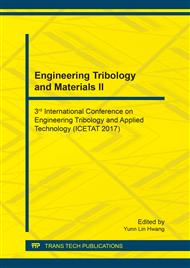[1]
K.D. Esmeryan, I.D. Avramov and E.I. Radeva: Temperature frequency characteristics of hexamethyldisiloxane (HMDSO) polymer coated Rayleigh surface acoustic wave (SAW) resonators for gas-phase sensor applications. Micromachines, Vol. 3 (2012).
DOI: 10.3390/mi3020413
Google Scholar
[2]
A. Schwirtz and H. Seeger: Comparison of the robustness and functionality of three adrenaline auto-injectors. J Asthma Allergy, Vol. 5 (2012), pp.39-49.
DOI: 10.2147/jaa.s33688
Google Scholar
[3]
S.H. Wang, C.Y. Shen, J.M. Su and S.W. Chang: A room temperature nitric oxide gas sensor based on a copper-ion-doped polyaniline/tungsten oxide nanocomposite. Sensors, Vol. 15 (2015), pp.7084-7095.
DOI: 10.3390/s150407084
Google Scholar
[4]
P.T. Zwierczyk and K. Varadi: Thermal stress analysis of a railway wheel in sliding-rolling motion. ASME J. Tribol., Vol. 136 (2014), p.1–8.
DOI: 10.1115/1.4027544
Google Scholar
[5]
K. Handa and F. Morimoto: Influence of wheel/rail tangential traction force on thermal cracking of railway wheels. WEAR, Vol. 289 (2012), p.112–118.
DOI: 10.1016/j.wear.2012.04.008
Google Scholar
[6]
H. Blok: Theoretical study of temperature rise at surfaces of actual contact under oiliness lubricating conditions. Proc. Inst. Mech. Eng., Vol. 2 (1937), p.222–235.
Google Scholar
[7]
J.C. Jaeger: Moving sources of heat and the temperature at sliding surfaces. J. proc. R. Soc. N.S.W., Vol. 76 (1942), p.203–224.
Google Scholar
[8]
X. Tian and F.E. Kennedy: Maximum and average flash temperatures in sliding contacts. ASME J. Tribol., Vol. 116 (1994), p.167–174.
DOI: 10.1115/1.2927035
Google Scholar
[9]
S. Wang and K. Komvopoulos: A fractal theory of the interfacial temperature distribution in the slow sliding regime: part i – elastic contact and heat transfer analysis. ASME J. Tribol., Vol. 116 (1994), p.812–822.
DOI: 10.1115/1.2927339
Google Scholar
[10]
K. Knothe and S. Liebelt: Determination of temperatures for sliding contact with applications for wheel-rail systems. WEAR, Vol. 189 (1995), p.91–99.
DOI: 10.1016/0043-1648(95)06666-7
Google Scholar
[11]
M. Haghpanahi, S. Salimi, P. Bahemmat, S. Sima: 3-D transient analytical solution based on green's function to temperature field in friction stir welding Appl. Math. Model., Vol. 37 (2013), p.9865–9884.
DOI: 10.1016/j.apm.2013.05.034
Google Scholar
[12]
V.M. Kitetu, T. Onyango, J.K. Kwanza, N.M. Mutua: Determination of one dimensional temperature distribution in metallic bar using green's function method. AJAM., Vol. 1 (2013), p.55–70.
DOI: 10.11648/j.ajam.20130104.14
Google Scholar
[13]
S.B. Liu, Q.J. Wang, S. J. Harris: Surface normal thermoelastic displacement in moving rough contacts. ASME J. Tribol., Vol. 125 (2003), p.862–868.
DOI: 10.1115/1.1574517
Google Scholar
[14]
S.B. Liu and Q.J. Wang: Transient thermoelastic stress fields in a half-space. ASME J. Tribol., Vol. 125 (2003), p.33–43.
Google Scholar
[15]
W.W. Chen, Q.J. Wang and W. Kim: Transient Thermo-mechanical analysis of sliding electrical contacts of elasto-plastic bodies, thermal softening, and melting inception. ASME J. Tribol., Vol. 131 (2009), p.1–6.
DOI: 10.1115/1.3084214
Google Scholar
[16]
A.A. Yevtushenko and E.G. lvanyk: Ukhanska, 0.M. Transient temperature of local moving areas of sliding contact. Tribol. Int., Vol. 30 (1997), pp.209-214.
DOI: 10.1016/s0301-679x(96)00044-8
Google Scholar
[17]
N. Laraqi: An exact explicit analytical solution of the steady-state temperature in a half Space subjected to a moving circular heat source. ASME J. Tribol., Vol. 125 (2003), p.859–862.
DOI: 10.1115/1.1573233
Google Scholar
[18]
N. Ye and K. Komvopoulos: Three-Dimensional Finite Element Analysis of Elastic-Plastic Layered Media Under Thermomechanical Surface Loading. ASME J. Tribol., Vol. 125 (2003), p.52–59.
DOI: 10.1115/1.1497360
Google Scholar
[19]
P. Sahoo and B. Chatterjee: Adhikary, D. Finite element based elastic-plastic contact behaviour of a sphere against a rigid flat – effect of strain hardening. IJET., Vol. 2 (2010), p.1–6.
DOI: 10.1155/2012/472794
Google Scholar
[20]
S.M. Kulkarni, C.A. Rubin and G.T. Hahn: Elasto-plastic coupled temperature-displacement finite element analysis of two-dimensional rolling-sliding contact with a translating heat source. ASME J. Tribol., Vol. 113 (1991), p.93–101.
DOI: 10.1115/1.2920609
Google Scholar
[21]
G. Liu, G. Wanga and S.B. Liu: A three-dimensional thermal- mechanical asperity contact model for two nominally flat surfaces in contact. ASME J. Tribol., Vol. 123 (2000), p.595–602.
DOI: 10.1115/1.1308044
Google Scholar
[22]
X.F. Zhang, B. Lin and H. Xi: Validation of an analytical model for grinding temperature in surface grinding by cup wheel with numerical and experimental results. Int. J. Heat Mass Transfer, Vol. 58 (2013), p.29–42.
DOI: 10.1016/j.ijheatmasstransfer.2012.11.022
Google Scholar
[23]
A. Ovcharenko, M. Yang, K. Chun and F.E. Talke: Transient thermomechanical contact of an impacting sphere on a moving flat. ASME J. Tribol., Vol. 133 (2011), pp.031404-9.
DOI: 10.1115/1.4003996
Google Scholar
[24]
J.F. Lin, J.C. Chung, J.W. Chen and T.C. Liu: Thermal analysis of the transient temperatures arising at the contact spots of two sliding surfaces. ASME J. Tribol., Vol. 127 (2005), p.694–704.
DOI: 10.1115/1.2000983
Google Scholar
[25]
J.H. Horng, C.C. Wei, H.J. Tsai and B.C. Shiu: A study of surface friction and particle friction between rough surfaces. Wear, Vol. 267 (2009), pp.1257-1263.
DOI: 10.1016/j.wear.2009.02.017
Google Scholar
[26]
S.Y. Chern, J.H. Horng and S.H. Chen: Study of temperature distributions of sliding block with asperity surface. SIA., Vol. 43 (2011), p.1509–1513.
DOI: 10.1002/sia.3745
Google Scholar
[27]
H.W. Wu, Y.Y. Chen and J.H. Horng: Contact temperature under three-body dry friction conditions. WEAR, Vols. 330–331 (2015), p.85–92.
DOI: 10.1016/j.wear.2015.01.060
Google Scholar


